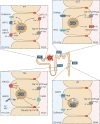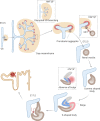Mechanisms of ion transport regulation by HNF1β in the kidney: beyond transcriptional regulation of channels and transporters
- PMID: 35554666
- PMCID: PMC9338905
- DOI: 10.1007/s00424-022-02697-5
Mechanisms of ion transport regulation by HNF1β in the kidney: beyond transcriptional regulation of channels and transporters
Erratum in
-
Correction to: Mechanisms of ion transport regulation by HNF1β in the kidney: beyond transcriptional regulation of channels and transporters.Pflugers Arch. 2022 Aug;474(8):917. doi: 10.1007/s00424-022-02706-7. Pflugers Arch. 2022. PMID: 35608669 Free PMC article. No abstract available.
Abstract
Hepatocyte nuclear factor 1β (HNF1β) is a transcription factor essential for the development and function of the kidney. Mutations in and deletions of HNF1β cause autosomal dominant tubule interstitial kidney disease (ADTKD) subtype HNF1β, which is characterized by renal cysts, diabetes, genital tract malformations, and neurodevelopmental disorders. Electrolyte disturbances including hypomagnesemia, hyperuricemia, and hypocalciuria are common in patients with ADTKD-HNF1β. Traditionally, these electrolyte disturbances have been attributed to HNF1β-mediated transcriptional regulation of gene networks involved in ion transport in the distal part of the nephron including FXYD2, CASR, KCNJ16, and FXR. In this review, we propose additional mechanisms that may contribute to the electrolyte disturbances observed in ADTKD-HNF1β patients. Firstly, kidney development is severely affected in Hnf1b-deficient mice. HNF1β is required for nephron segmentation, and the absence of the transcription factor results in rudimentary nephrons lacking mature proximal tubule, loop of Henle, and distal convoluted tubule cluster. In addition, HNF1β is proposed to be important for apical-basolateral polarity and tight junction integrity in the kidney. Interestingly, cilia formation is unaffected by Hnf1b defects in several models, despite the HNF1β-mediated transcriptional regulation of many ciliary genes. To what extent impaired nephron segmentation, apical-basolateral polarity, and cilia function contribute to electrolyte disturbances in HNF1β patients remains elusive. Systematic phenotyping of Hnf1b mouse models and the development of patient-specific kidney organoid models will be essential to advance future HNF1β research.
Keywords: Apical-basolateral polarity; Electrolyte disturbances; HNF1β; Kidney development; Transcriptional regulation.
© 2022. The Author(s).
Conflict of interest statement
The authors declare no competing interests.
Figures


Similar articles
-
HNF1B Transcription Factor: Key Regulator in Renal Physiology and Pathogenesis.Int J Mol Sci. 2024 Oct 2;25(19):10609. doi: 10.3390/ijms251910609. Int J Mol Sci. 2024. PMID: 39408938 Free PMC article. Review.
-
Transcription factor HNF1β controls a transcriptional network regulating kidney cell structure and tight junction integrity.Am J Physiol Renal Physiol. 2023 Feb 1;324(2):F211-F224. doi: 10.1152/ajprenal.00199.2022. Epub 2022 Dec 22. Am J Physiol Renal Physiol. 2023. PMID: 36546837
-
Transcription factor HNF1β regulates expression of the calcium-sensing receptor in the thick ascending limb of the kidney.Am J Physiol Renal Physiol. 2018 Jul 1;315(1):F27-F35. doi: 10.1152/ajprenal.00601.2017. Epub 2018 Mar 21. Am J Physiol Renal Physiol. 2018. PMID: 29561186
-
Loss of transcriptional activation of the potassium channel Kir5.1 by HNF1β drives autosomal dominant tubulointerstitial kidney disease.Kidney Int. 2017 Nov;92(5):1145-1156. doi: 10.1016/j.kint.2017.03.034. Epub 2017 May 31. Kidney Int. 2017. PMID: 28577853 Free PMC article.
-
Hnf1beta and nephron segmentation.Pediatr Nephrol. 2014 Apr;29(4):659-64. doi: 10.1007/s00467-013-2662-x. Epub 2013 Nov 5. Pediatr Nephrol. 2014. PMID: 24190171 Free PMC article. Review.
Cited by
-
Characterization of the human fetal gonad and reproductive tract by single-cell transcriptomics.Dev Cell. 2024 Feb 26;59(4):529-544.e5. doi: 10.1016/j.devcel.2024.01.006. Epub 2024 Jan 30. Dev Cell. 2024. PMID: 38295793 Free PMC article.
-
HNF1B Transcription Factor: Key Regulator in Renal Physiology and Pathogenesis.Int J Mol Sci. 2024 Oct 2;25(19):10609. doi: 10.3390/ijms251910609. Int J Mol Sci. 2024. PMID: 39408938 Free PMC article. Review.
-
The kidneys matter.Pflugers Arch. 2022 Aug;474(8):755-757. doi: 10.1007/s00424-022-02737-0. Pflugers Arch. 2022. PMID: 35895104 Free PMC article. No abstract available.
-
Navigating the multifaceted intricacies of the Na+-Cl- cotransporter, a highly regulated key effector in the control of hydromineral homeostasis.Physiol Rev. 2024 Jul 1;104(3):1147-1204. doi: 10.1152/physrev.00027.2023. Epub 2024 Feb 8. Physiol Rev. 2024. PMID: 38329422 Free PMC article. Review.
References
-
- Aboudehen K, Kim MS, Mitsche M, Garland K, Anderson N, Noureddine L, Pontoglio M, Patel V, Xie Y, DeBose-Boyd R, Igarashi P. Transcription factor hepatocyte nuclear factor-1 regulates renal cholesterol metabolism. J Am Soc Nephrol. 2016;27:2408–2421. doi: 10.1681/ASN.2015060607. - DOI - PMC - PubMed
-
- Aboudehen K, Noureddine L, Cobo-Stark P, Avdulov S, Farahani S, Gearhart MD, Bichet DG, Pontoglio M, Patel V, Igarashi P. Hepatocyte nuclear factor–1 β regulates urinary concentration and response to hypertonicity. J Am Soc Nephrol. 2017;28:2887–2900. doi: 10.1681/ASN.2016101095. - DOI - PMC - PubMed
-
- Adalat S, Woolf AS, Johnstone KA, Wirsing A, Harries LW, Long DA, Hennekam RC, Ledermann SE, Rees L, Van HW, Marks SD, Trompeter RS, Tullus K, Winyard PJ, Cansick J, Mushtaq I, Dhillon HK, Bingham C, Edghill EL, Shroff R, Stanescu H, Ryffel GU. HNF1B mutations associate with hypomagnesemia and renal magnesium wasting. J Am Soc Nephrol. 2009;20:1123–1131. doi: 10.1681/ASN.2008060633. - DOI - PMC - PubMed
Publication types
MeSH terms
Substances
LinkOut - more resources
Full Text Sources

